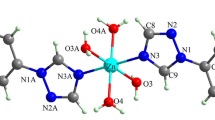Abstract
The crystal packings of two charge-transfer complexes based on tetrathiafulvalene and substituted fluorenes-2,4,5,7-tetranitro-9-dicyanomethylenefluorene (in complex I) or 2,7-dicyano-4,5-dinitro-9-dicyanomethylenefluorene (in complex II)— are analyzed. Crystals of complex II involve a third component, namely, C6H5Cl solvate molecules. Crystals of both complexes are characterized by the formation of stacks composed of alternating donor and acceptor molecules and sheets in which the molecules are linked through different-type weak interactions. In structure II, chlorobenzene molecules occupy cavities that are formed in stacks in the vicinity of the tetrathiafulvalene molecules due to the larger difference in size of the donor and acceptor molecules in complex II as compared to that in complex I. The chlorobenzene molecules provide a close packing. These molecules are involved in the system of weak interactions to form the Cl⋯N and C-H⋯N secondary bonds with the CN groups of the acceptor molecules in the sheets.
Similar content being viewed by others
References
V. Khodorhovsky and J. Y. Becker, in Organic Conductors: Fundamentals and Applications, Ed. by J.-P. Farges (Marcel Dekker, New York, 1995).
J. Ferraris, D. O. Cowan, V. V. Walatka, and J. H. Perlstein, J. Am. Chem. Soc. 95, 948 (1973).
M. R. Bryce, Chem. Soc. Rev. 20, 355 (1991).
A. Krief, Tetrahedron 42, 1209 (1986).
K. Kobayashi and Y. Mazaki, J. Synth. Org. Chem. (Jpn.) 46, 639 (1988).
A. Aumüller and S. Hünig, Angew. Chem., Int. Ed. Engl. 23, 447 (1984).
S. Hünig, Pure Appl. Chem. 62, 395 (1990).
P. Erk, H. Meixner, T. Metzenthin, et al., Adv. Mater. 3, 311 (1991).
K. Sinzger, S. Hünig, M. Jopp, et al., J. Am. Chem. Soc. 115, 7696 (1993).
S. Hünig, J. Mater. Chem. 10, 1469 (1995).
G. R. Desiraju, Chem. Commun., 1475 (1997).
G. R. Desiraju, Angew. Chem., Int. Ed. Engl. 34, 2311 (1995).
G. R. Desiraju, in Comprehensive Supramolecular Chemistry, Ed. by D. D. MacNicols, F. Toda, and R. Bishop (Pergamon, New York, 1996), Vol. 6, pp. 1–22.
G. R. Desiraju, Curr. Opin. Solid State Mater. Sci., 451 (1997).
J. D. Dunitz, in The Crystal as a Supramolecular Entity, Ed. by G. R. Desiraju (Wiley, Chichester, 1996), pp. 1–30.
G. R. Desiraju, Crystal Engineering: The Design of Organic Solids (Elsevier, Amsterdam, 1989).
D. D. Mysyk, I. F. Perepichka, and N. I. Sokolov, J. Chem. Soc., Perkin Trans. 2, 537 (1997).
D. D. Mysyk, N. M. Sivchenkova, V. É. Kampar, and O. Ya. Neiland, Izv. Akad. Nauk Latv. SSR, Ser. Khim., 621 (1987).
I. F. Perepichka, D. D. Mysyk, and N. I. Sokolov, in Current Trends in Polymer Photochemistry, Ed. by N. S. Allen, I. R. Bellobono, M. Edge, and E. Selli (Ellis Horwood, London, 1995), pp. 318–327.
Yu. P. Getmanchuk and N. I. Sokolov, in Fundamentals of Optical Memory and Media (Vishcha Shkola, Kiev, 1983), issue 14, p. 11.
P. Strohriegl and J. V. Grazulevicius, in Handbook of Organic Conductive Molecules and Polymers, Ed. by H. S. Nalwa (Wiley, Chichester, 1997), Vol. 1, p. 553.
S. Horiuchi, H. Yamochi, G. Saito, et al., J. Am. Chem. Soc. 118, 8604 (1996).
I. F. Perepichka, L. G. Kuz’mina, D. F. Perepichka, et al., J. Org. Chem. 63, 6484 (1998).
L. G. Kuz’mina, Koord. Khim. 25(9), 643 (1999).
A. Ellern, J. Bernstein, J. Y. Becker, et al., Chem. Mater. 6, 1378 (1994).
W. F. Cooper, J. W. Edmonds, F. Wudl, and P. Coppens, Cryst. Struct. Commun. 3, 23 (1974).
F. Vögtle, in Supramolecular Chemistry: An Introduction (Wiley, Chichester, 1991), pp. 290–312.
Author information
Authors and Affiliations
Additional information
__________
Translated from Kristallografiya, Vol. 47, No. 2, 2002, pp. 286–296.
Original Russian Text Copyright © 2002 by Kuz’mina, I. Perepichka, D. Perepichka, Howard, Bryce.
Rights and permissions
About this article
Cite this article
Kuz’mina, L.G., Perepichka, I.F., Perepichka, D.F. et al. Supramolecular architecture of two charge-transfer complexes based on 2,7-(X, X)-4,5-dinitro-9-dicyanomethylenefluorenes (X = NO2 or CN) and tetrathiafulvalene. Crystallogr. Rep. 47, 251–261 (2002). https://doi.org/10.1134/1.1466501
Received:
Issue Date:
DOI: https://doi.org/10.1134/1.1466501




